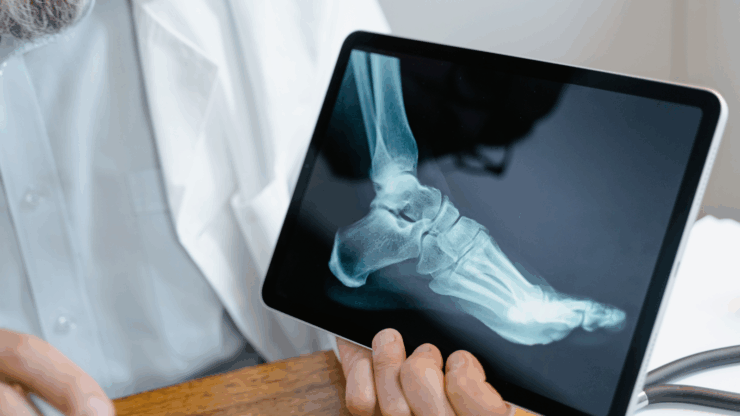
How Modern Podiatry Supports Mobility in Older Adults
As we age, staying mobile means everything. It allows us to maintain independence, stay connected to our communities, and continue doing the things we love. But for many older adults, foot pain and instability can gradually chip away at that freedom. West Coast Podiatry Center’s mission is to help patients regain confidence with every step—and thanks to modern podiatry, this is more possible today than ever before.
This article highlights effective tools and strategies that are now available to support foot health and mobility in older adults, most of which are non-surgical or minimally invasive.
Why does foot health decline with age?
Our feet endure a lifetime of use, and aging takes a toll through the following changes:
- The fat pads that cushion our feet wear thin
- Joints become stiff or arthritic
- Circulation decreases
- Nerve sensitivity diminishes
- Skin and nails become more fragile
These changes increase the risk of conditions ranging from plantar fasciitis and neuropathy to foot ulcers and instability. With early detection and access to modern care, many of these issues can be managed conservatively.
Plantar fasciitis & heel pain
Heel pain, often caused by plantar fasciitis, is one of the most common reasons older adults visit a podiatrist. In the past, treatment might have focused on rest and generic insoles, but today, there are more options:
Modern non-surgical options:
- Laser therapy: This FDA-cleared, non-invasive treatment uses focused light to stimulate healing, reduce inflammation, and relieve pain without downtime.
- Custom orthotics (digitally designed): With medical-grade orthotics using advanced 3D scanning and pressure mapping to offload stress and correct foot mechanics precisely.
- Shockwave therapy (EPAT): A non-invasive technique that promotes healing by stimulating blood flow and tissue regeneration.
- Stretching programs & physical therapy referrals: Tailored to your specific gait and muscle imbalances.
Fat pad atrophy
As the natural cushioning on the bottom of the feet wears away, walking can become painful, even in supportive shoes. Non-surgical advances include:
- Injectable fillers or fat grafting: In-office procedures that restore lost volume in high-pressure areas.
- Custom offloading insoles: Designed specifically to distribute pressure away from painful zones.
- Personalized shoe recommendations: We live, work, and walk on hard surfaces. The right shoe can ease discomfort.
Neuropathy and balance loss
Peripheral neuropathy, often resulting from diabetes or circulatory issues, impairs balance and increases fall risk. Some solutions include:
- MR3 TempTouch® monitoring: A home-use device that detects temperature changes in the foot, indicating early-stage inflammation or ulcer formation before symptoms appear.
- Balance-enhancing orthotics: Some orthotics are designed not only for comfort, but also to improve proprioception (your brain’s awareness of foot position) which helps prevent falls.
Toenail & skin health
Thickened toenails, fungal infections, and dry skin are more than cosmetic concerns. They can lead to infections and mobility limitations.
Simple approaches include:
- Non-pharmaceutical antifungal treatment (e.g., ToeFX): A non-drug, pain-free approach to managing nail fungus with no side effects.
- Advanced skin treatments: Including hydrating foams, urea-based lotions, and wound care dressings for cracked or compromised skin.
Fall risk & gait instability
Foot problems are a hidden but significant contributor to falls in older adults. If you’re experiencing balance issues or a fear of falling, a podiatric exam can help uncover the underlying cause.
Fall-prevention toolkit:
- Gait analysis technology: In-office platforms assess your walking pattern, step by step, and identify potential risks.
- Fall-risk balance assessment: We use science-based fall risk assessments and recommend appropriate interventions to reduce the risk of falls.
- Strengthening plans & home exercises: We can coordinate with physical therapists to support your stability.
What can you do now?
Even if you’re not experiencing significant discomfort today, taking care of your feet now can help you avoid serious problems later. Here’s how to get started:
Inspect your feet daily. Use a mirror or ask for help if needed.
Moisturize daily. Especially around the heels and sides of the feet. Avoid moisturizing between the toes.
Wear appropriate footwear. Avoid sandals, slippers, or high heels with little support.
Get your feet professionally evaluated. A quick, painless check-up with a podiatrist can help identify minor problems before they become major issues.
A commitment to patient-centered care
West Coast Podiatry Center offers the latest evidence-based, non-surgical treatments in a warm, supportive environment. Whether you’re in Sarasota, Bradenton, or Venice, the team is available to help you walk stronger, feel better, and live fully.
Combining traditional clinical expertise with advanced technologies—including laser therapy, custom orthotics, and regenerative options like amniotic grafts for wound healing—the center offers patients access to the most comprehensive podiatric care available today.
Modern podiatry is not about simply managing foot pain. It’s about restoring quality of life, independence, and peace of mind. If you’re an older adult or caring for one, know that you don’t have to live with foot discomfort or instability. There are more tools and treatments available than ever before, and most of them don’t involve surgery or long recoveries.
Your feet have supported you for a lifetime. Make sure you support them in return!
FAQ: When should you see a podiatrist?
Many people wait too long to seek help for foot or ankle issues, assuming pain is a normal part of aging. The truth is that most foot problems are highly treatable, especially when caught early. Here are signs it’s time to schedule a podiatric appointment:
Persistent foot or ankle pain
If you’ve had foot or heel pain lasting more than a few days, especially if it affects your ability to walk or stand—get it evaluated.
Numbness, tingling, or burning
These are signs of possible nerve damage or peripheral neuropathy, which require prompt attention.
Difficulty walking or balancing
Struggling with stability, favoring one foot, or feeling unsteady could mean a structural issue, gait imbalance, or muscle weakness in the foot or ankle.
Sudden swelling or redness
Unexplained swelling, warmth, or discoloration in the foot or ankle could indicate infection, gout, or poor circulation.
Changes in skin or nails
Thickened nails, sores that won’t heal, or cracked skin might seem minor but it can signal larger problems, especially in those with diabetes.
History of diabetes
If you’re diabetic, you should see a podiatrist at least once a year, even if you feel fine.
Wounds or ulcers
A non-healing sore or ulcer is a red flag and needs expert wound care as soon as possible.
Trouble caring for your feet
If arthritis, vision problems, or flexibility issues make it hard to trim nails or inspect your feet, a podiatrist can help manage routine care and prevent complications.


















